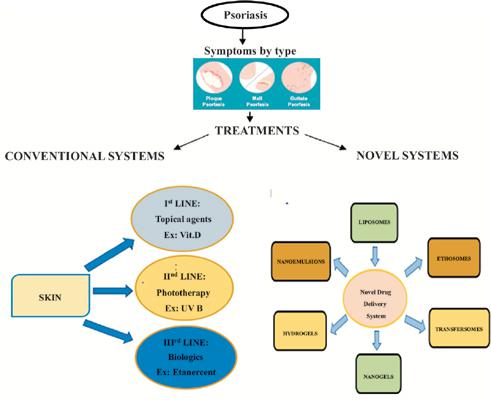Recent Patents on Nanotechnology ( IF 2.0 ) Pub Date : 2020-05-31 , DOI: 10.2174/1872210514666200204124130 Kalpana Pandey 1 , Nimisha 1

|
Background: Psoriasis is a chronic autoimmune disorder of the skin which is characterized by the reoccurring episodes of inflammatory lesions with a worldwide occurrence of around 2-5%. Psoriasis can be categorized as mild, moderate and severe conditions. In mild psoriasis, there is the formation of rashes, and when it becomes moderate, the skin turns scaly. In severe conditions, the red patches can be seen on the skin surface and the skin becomes itchy. The different treatment approaches include phototherapy, topical, oral and other systemic drug deliveries. Dermal treatment is now highly endorsed in topical indications for psoriatic patients, due to its higher penetration which can be achieved using pharmaceutical carriers.
Objective: Though various conventional formulations are there, therapeutic benefits can be provided only to a limited extent. The objective of this review was to highlight newer biocompatible and biodegradable materials like phospholipids, and forefront drug delivery methods like liposomes, microemulsions, nanoemulsions, niosomes, ethosomes, etc. which has increased the possibility to improve the efficacy and safety of the topical products. Apart from this, many medicinal plants are available in nature that are used for treating skin diseases like psoriasis.
Conclusion: The new trends in nanotechnology are marked by subsequent changes in the pharmaceutical research field. To safeguard the research works in the research field, various patents have been introduced, such as Glaxo Smith Kline (GSK 2981278) – RORγ antagonist, etc. The causes, pathophysiology and the herbal plants that are used in treating the disease are also discussed.
中文翻译:

牛皮癣的有前途的纳米技术方法的概述。
背景:牛皮癣是一种皮肤的慢性自身免疫性疾病,其特征是炎症性病变反复发作,全世界范围内发生率约2%至5%。牛皮癣可分为轻度,中度和重度疾病。在轻度牛皮癣中,会形成皮疹,当皮疹变得中度时,皮肤就会变成鳞屑。在严酷的条件下,可以在皮肤表面看到红色斑块,并且皮肤发痒。不同的治疗方法包括光疗,局部,口服和其他全身性药物递送。由于牛皮癣患者的穿透力更高,因此可以使用药物载体实现皮肤治疗,因此在牛皮癣患者的局部适应症中得到了高度认可。
目的:尽管有各种常规配方,但只能在有限的程度上提供治疗效果。这篇综述的目的是重点介绍更新的生物相容性和可生物降解材料,例如磷脂,以及最前沿的药物递送方法,例如脂质体,微乳剂,纳米乳剂,脂质体,质体等,这增加了改善局部用药的功效和安全性的可能性。除此之外,自然界中有许多药用植物可用于治疗皮肤病,如牛皮癣。
结论:纳米技术的新趋势以药物研究领域的后续变化为标志。为了保护研究领域中的研究工作,已引入了各种专利,例如葛兰素史克(GSK 2981278)–RORγ拮抗剂等。还讨论了治疗该病的原因,病理生理和草药植物。











































 京公网安备 11010802027423号
京公网安备 11010802027423号